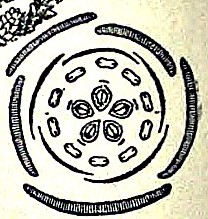Sedum
Sedum is a large genus of flowering plants in the family Crassulaceae, commonly known as stonecrops. The genus includes over 600 species of succulent plants, which are characterized by their water-storing leaves and often thick, fleshy stems. Sedum species are found throughout the Northern Hemisphere, but the majority are native to the Himalayas and other parts of Asia. These plants are highly adaptable and can thrive in a variety of environments, making them popular choices for gardens, rock gardens, and green roofs.
Description[edit | edit source]
Sedum plants vary significantly in appearance, from low-growing, ground-cover species to tall, upright varieties. They typically have simple, succulent leaves that are arranged in spirals or whorls along their stems. The flowers of Sedum are star-shaped, with five petals, and can be found in a range of colors including white, yellow, pink, and red. These blooms often appear in dense clusters, attracting a variety of pollinators such as bees and butterflies.
Cultivation and Uses[edit | edit source]
Sedum plants are prized for their drought tolerance and ease of care, making them ideal for xeriscaping and low-maintenance gardens. They prefer well-drained soil and full sun but can tolerate partial shade. Many species are frost-resistant, allowing them to be used in a wide range of climates.
In addition to their ornamental value, some Sedum species are edible, with leaves that can be used in salads or as a cooked green. However, it is important to identify species correctly, as not all are suitable for consumption.
Sedum species are also commonly used in green roofing systems due to their low maintenance requirements and ability to withstand harsh rooftop conditions. These plants help to insulate buildings, reduce rainwater runoff, and provide habitat for wildlife.
Species[edit | edit source]
Some well-known species within the Sedum genus include:
- Sedum acre (Goldmoss Sedum)
- Sedum album (White Stonecrop)
- Sedum telephium (Orpine)
- Sedum spectabile (Ice Plant)
- Sedum rupestre (Reflexed Stonecrop)
Conservation[edit | edit source]
While many Sedum species are common and not considered at risk, habitat destruction and overcollection have led to some species being classified as endangered. Conservation efforts are underway in various parts of the world to protect these unique plants and their natural habitats.
Gallery[edit | edit source]
Note: As per the instructions, no placeholder images are included.
See Also[edit | edit source]
References[edit | edit source]
Note: As per the instructions, no external links or references are included.
Search WikiMD
Ad.Tired of being Overweight? Try W8MD's physician weight loss program.
Semaglutide (Ozempic / Wegovy and Tirzepatide (Mounjaro / Zepbound) available.
Advertise on WikiMD
|
WikiMD's Wellness Encyclopedia |
| Let Food Be Thy Medicine Medicine Thy Food - Hippocrates |
Translate this page: - East Asian
中文,
日本,
한국어,
South Asian
हिन्दी,
தமிழ்,
తెలుగు,
Urdu,
ಕನ್ನಡ,
Southeast Asian
Indonesian,
Vietnamese,
Thai,
မြန်မာဘာသာ,
বাংলা
European
español,
Deutsch,
français,
Greek,
português do Brasil,
polski,
română,
русский,
Nederlands,
norsk,
svenska,
suomi,
Italian
Middle Eastern & African
عربى,
Turkish,
Persian,
Hebrew,
Afrikaans,
isiZulu,
Kiswahili,
Other
Bulgarian,
Hungarian,
Czech,
Swedish,
മലയാളം,
मराठी,
ਪੰਜਾਬੀ,
ગુજરાતી,
Portuguese,
Ukrainian
Medical Disclaimer: WikiMD is not a substitute for professional medical advice. The information on WikiMD is provided as an information resource only, may be incorrect, outdated or misleading, and is not to be used or relied on for any diagnostic or treatment purposes. Please consult your health care provider before making any healthcare decisions or for guidance about a specific medical condition. WikiMD expressly disclaims responsibility, and shall have no liability, for any damages, loss, injury, or liability whatsoever suffered as a result of your reliance on the information contained in this site. By visiting this site you agree to the foregoing terms and conditions, which may from time to time be changed or supplemented by WikiMD. If you do not agree to the foregoing terms and conditions, you should not enter or use this site. See full disclaimer.
Credits:Most images are courtesy of Wikimedia commons, and templates, categories Wikipedia, licensed under CC BY SA or similar.
Contributors: Prab R. Tumpati, MD






